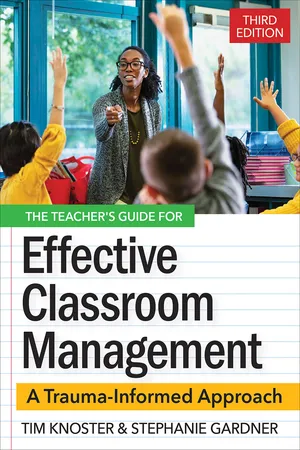
The Teacher's Guide for Effective Classroom Management
A Trauma-Informed Approach
- 144 pages
- English
- ePUB (mobile friendly)
- Available on iOS & Android
The Teacher's Guide for Effective Classroom Management
A Trauma-Informed Approach
About this book
Apply a trauma-informed lens to classroom management with the timely third edition of this bestselling book—soon to be a go-to guide for every K–12 teacher. Developed by experts on trauma-informed and positive behavior support, this new edition offers practical guidance for creating a safe, supportive, and smoothly functioning classroom environment for all learners, including those who have experienced trauma.
Written in the down-to-earth, accessible style that made the previous editions teacher favorites, this guide will help preservice, new, and experienced educators address each student’s social, emotional, and behavioral needs throughout the school day. Reflecting empirically supported practice, the recommended strategies fit perfectly within a multi-tiered systems of support (MTSS) framework and align with school-wide positive behavioral interventions and supports. And the updated practical materials—now available online—help teachers with planning, data collection, student engagement, and more.
With the principles and practices in this reader-friendly guidebook, teachers will be better prepared to resolve behavior challenges, mitigate the impact of trauma, and foster a safe and nurturing learning community where every student can succeed.
TEACHERS WILL:
- learn how trauma can uniquely influence student behavior
- build rapport with students while maintaining appropriate boundaries
- establish clear expectations to enhance social emotional learning and behavior in the classroom
- acknowledge and reinforce expected prosocial behaviors throughout the school day
- increase student engagement through opportunities to respond
- use trauma-informed redirection procedures to address behavior challenges
- align their classroom practice with trauma-informed Tier 2 and Tier 3 approaches
- discover self-care tips and resources to help teachers navigate stress and avoid burnout
WHAT’S NEW: Timely focus on trauma and trauma-informed strategies • Guidance on both traditional and virtual instruction • Reflection exercises at the end of each chapter • Updated practical materials (now online) • Updated citations and references
Frequently asked questions
- Essential is ideal for learners and professionals who enjoy exploring a wide range of subjects. Access the Essential Library with 800,000+ trusted titles and best-sellers across business, personal growth, and the humanities. Includes unlimited reading time and Standard Read Aloud voice.
- Complete: Perfect for advanced learners and researchers needing full, unrestricted access. Unlock 1.4M+ books across hundreds of subjects, including academic and specialized titles. The Complete Plan also includes advanced features like Premium Read Aloud and Research Assistant.
Please note we cannot support devices running on iOS 13 and Android 7 or earlier. Learn more about using the app.
Information
Table of contents
- Cover
- Title Page
- Copyright Page
- Contents
- About the Online Companion Materials
- About the Authors
- Preface
- Introduction
- Chapter 1: What Exactly Is a Trauma-Informed Approach?
- Chapter 2: Why Do Kids Act the Way They Do?
- Chapter 3: Becoming Trauma-Informed
- Chapter 4: Preventing Undesired Behavior
- Chapter 5: Building Rapport
- Chapter 6: Establishing Expectations Reflecting Social and Emotional Learning
- Chapter 7: Acknowledging Desired Behaviors
- Chapter 8: Providing Increased Opportunities for Student Engagement
- Chapter 9: Addressing Undesired Behavior
- Chapter 10: Helping Students With Mental Health and Wellness
- Chapter 11: Trauma-Informed Multi-Tiered Systems of Support
- Closing Thoughts on Self-Care
- Appendix A: The Three Bees (Elementary School)
- Appendix B: Expected Behavior (Middle School)
- Appendix C: Performance Expectations (High School)
- Appendix D: Expectations Planning Matrix With Embedded Social and Emotional Learning
- Appendix E: Strategies for Self-Monitoring the 4:1 Ratio in the Classroom
- Appendix F: Monitoring Achievement of the 4:1 Ratio
- Appendix G: Student Response Cards
- Appendix H: Opportunities to Respond (OTR) Response Sheet
- Appendix I: Opportunities to Respond Data Collection Form (for Teacher Self-Reflection)
- Appendix J: Behavior Progress Report (Primary Classroom)
- Appendix K: Behavior Progress Report (Middle or Secondary Classroom)
- Appendix L: Behavior Contract
- Appendix M: Guidance for Starting the Conversation About Schoolwide Positive Behavior Intervention and Support (PBIS)
- Appendix N: Tips for Teaming When Designing and Implementing a Student-Centered Behavior Support Plan
- Appendix O: Guiding Thoughts for Organizing a Student-Centered Behavior Support Team
- Appendix P: Linking Strategies and Interventions to Hypotheses
- Appendix Q: Keys to Implementing a Student-Centered Behavior Support Plan
- References
- Index
- Back Ad
- Back Cover